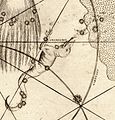Wikipedia:Today's featured article/December 21, 2017
Musca (fly) is a small constellation in the deep southern sky. It was one of twelve constellations created by Petrus Plancius from the observations of Pieter Dirkszoon Keyser and Frederick de Houtman, first appearing on a 35-centimetre (14-inch) diameter celestial globe by Plancius and Jodocus Hondius published in 1597 or 1598 in Amsterdam. The first depiction in a celestial atlas was in Johann Bayer's Uranometria of 1603. Musca remains below the horizon for most Northern Hemisphere observers. Many of the constellation's brighter stars are in the Scorpius–Centaurus Association, hot blue-white stars that appear to share a common origin and motion across the Milky Way. These include Alpha, Beta, Gamma, Zeta2 and (likely) Eta Muscae, as well as HD 100546, a blue-white Herbig Ae/Be star that is surrounded by a complex debris disk containing a large planet or brown dwarf and possible protoplanet. Two further star systems have been found to have planets. The constellation also contains two Cepheid variables visible to the naked eye. Theta Muscae is a triple star system, the brightest member of which is a Wolf–Rayet star. (Full article...)

